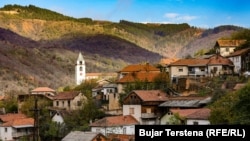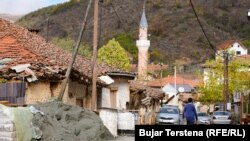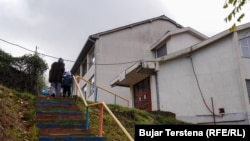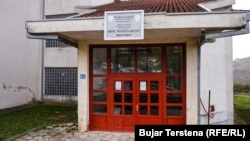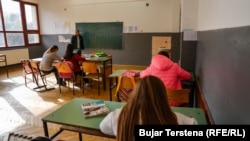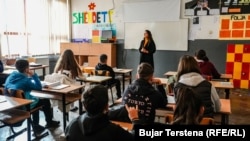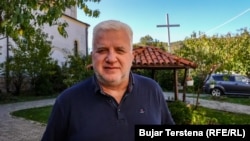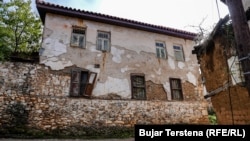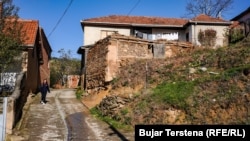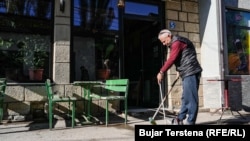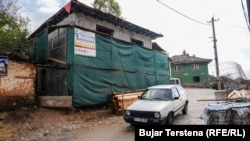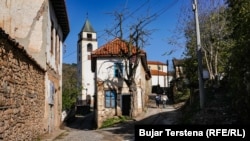JANJEVO, Kosovo -- In the narrow streets of Janjevo, Kosovo, a sense of tranquility prevails, occasionally broken by the ringing of the church bell or the call to prayer from the village mosque.
The Catholic church, built in 1856 and devoted to St. Nicholas, lies a few hundred meters near the 400-year-old mosque, where their followers coexist peacefully.
In Janjevo, part of the municipality of Lipljan, one can experience a diverse community that embraces a harmonious coexistence with various ethnic groups that include Croats, Albanians, Turks, and Roma.
"There would be no [interethnic] problems in Kosovo if everywhere was like Janjevo," says Olga Glicic, a Croat who calls the small village, located some 20 kilometers from the capital, Pristina, her home.
Her sentiments are echoed by Nuredin Imeri, who hails from the Albanian community. "We are all like one house," he says.
One School, Two Systems
Glicic serves as deputy director of a primary school following the Kosovar school curriculum. Classes are also offered in accordance with the Serbian curriculum in the same building.
About 200 students from the Albanian and Turkish communities follow the Kosovar system, while 50 students from the Croatian and Romany communities learn in the Serbian language.
"We all enter this school [through the same entrance]. We don't have any problems. There is no politics in our school," Glicic added.
Goran Janicijevic, the director of the Serbian-language school, corroborates her statements. Having only taken on the role a few days before, he was reluctant to talk about the novel strategy of having two systems, adding that he needs more time to study it.
After completing elementary school, children from the Croatian and Romany communities in Janjevo will continue their education at Gracanica, a secondary school run by the Serbian Education Ministry.
Albanians and Turks will go to Lipljan, where they will study according to the Kosovar system.
The 'Quiet Disappearance' Of Croats From Janjevo
According to Glicic, children from the Croatian community often study abroad in another EU member state after graduating from high school or college.
She adds that there used to be around 1,300 students from the Croatian community in Janjevo, while today there are only 12.
It's a far cry from the beginning of the 1990s, when there were almost 5,000 Croats in Janjevo. Today, only 150 of them live there.
The parish priest, Don Mate, says the "trigger" for the migration of Kosovo Croats was the Yugoslav War that tore the country apart in 1991.
Following the conflict, there was a significant wave of migration as many people fled the region seeking refuge and safety. The trend continued into the 2000s.
Dilapidated and abandoned houses around Janjevo also testify to the departure of the population.
"We have a lot of empty houses.... I tried to count (them), but every time it gets sadder. Every year another one or two families leave," says Mate.
On a few of these homes, one can find an inscription reading, "Cultural heritage as a driver of the economic revival of Janjevo."
Mate explains that young people go to Croatia for seasonal work, and that fewer and fewer of them return home.
"The fact that no one returns is a serious problem, except for one family that returned to Kosovo after spending two years in Croatia," Mate says.
The obstacles "to return, stay, and survive" in Kosovo, he adds, are economic.
Another issue is that the Croatian community in Kosovo does not have constitutional recognition. The constitution of Kosovo specifically recognizes the ethnic communities of Albanian, Serbs, and others, though it does not explicitly mention Croats, yet it does provide for the protection and promotion of the rights of all communities.
The historical background and demography of Kosovo are responsible for the lack of special constitutional status for Croats. Historically, the region's two most significant and dominant communities have been the Serb minority and the ethnic Albanian majority in Kosovo.
Officials have promised to make an effort toward their recognition, though it still has not happened.
A Disappearing Community
Mate, the parish priest, fondly recalls how Janjevo was once a thriving town.
"In the past, Janjevo was known for its artisans, merchants, and foundries. Almost every house was a mini-factory. Today, there are only three manufacturers left, and they are barely struggling to survive," he says.
Imeri also recalls the once prosperous people who created products that were well known throughout the former Yugoslavia.
"I was 14 years old when I earned my first dinar. All sorts of things were done: casting, plastics, costume jewelry, aluminum spoons, and forks were also created here in Janjevo," he says.
Today, Imeri is the owner of a cafe in the center of Janjevo, but he does not see any prospects for its future.
His children have already gone to Western countries in search of a better life.
"After the war, nothing good remained here," he adds before launching into a series of complaints about the poor infrastructure and communal services that affect the once-prosperous town.
No Work, No Future
At the entrance to Janjevo live members of the Romany community. One of them is Garip Ljeat, who is also tired of the poor social and economic situation.
"I don't work, there is no work anywhere. Sometimes I will get a small job," says Ljeat.
He adds that he has four children who have finished school but are also struggling to find employment.
Ljeat recalls how the once-thriving town of Janjevo once had industries that offered jobs for all of the communities, including the Romany community.
"Our community contributed, some were artisans themselves, but everything has changed now. There are no jobs, and no future," he concludes.
The EU Contribution
In 2021, the European Union started implementing a project aimed at preserving the cultural and religious heritage of Lipljan and the development of the local tourism industry.
The project, worth around two million euros, also involves the preservation and restoration of the historic center of Janjevo. The Kosovo government also allocated EUR 1.4 million.
The United Nations Development Program (UNDP) in Kosovo announced in May that works on the restoration of nine houses were underway and that the plan was to restore 14 buildings, as well as train tourist guides.
The Minister of Culture, Youth, and Sports in the Government of Kosovo, Hajrula Ceku, says that the historical center of Janjevo will be transformed into an attractive destination for visitors and that this will develop tourism and the local economy.
In the description of the project, called "Cultural heritage as a driver of the economic revival of Janjevo," it is written that the goal is to restore houses that will contribute to "reviving the history and memories of the Croatian families who once lived there, encouraging the return and preservation of the rich cultural heritage of Janjevo."
"The project will benefit all communities by creating opportunities for socio-economic revival and promoting local tourism," it adds.
However, Glicic does not believe that the renovations can restore the 'old glory' of Janjevo or bring back those who left their hometown.
"I wouldn't say that it can bring about positive changes. God forbid, but it's difficult," says the Croatian, who was born, grew up, and lives in Janjevo.
She adds that her ancestors are from Janjevo, that they lived there seven centuries ago, and that she herself will never leave her birthplace.
"Maybe one day I'll be alone; maybe there won't be anyone (from the Croatian community) left, but I'm ready for that," says Glicic.




